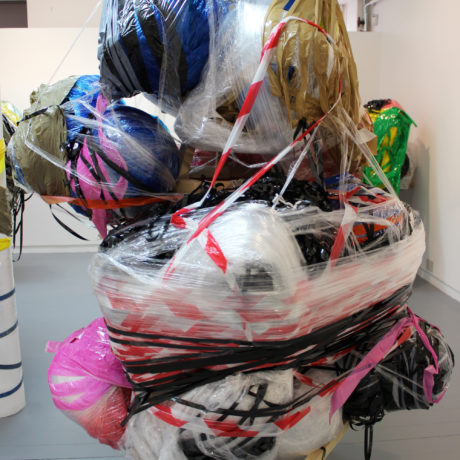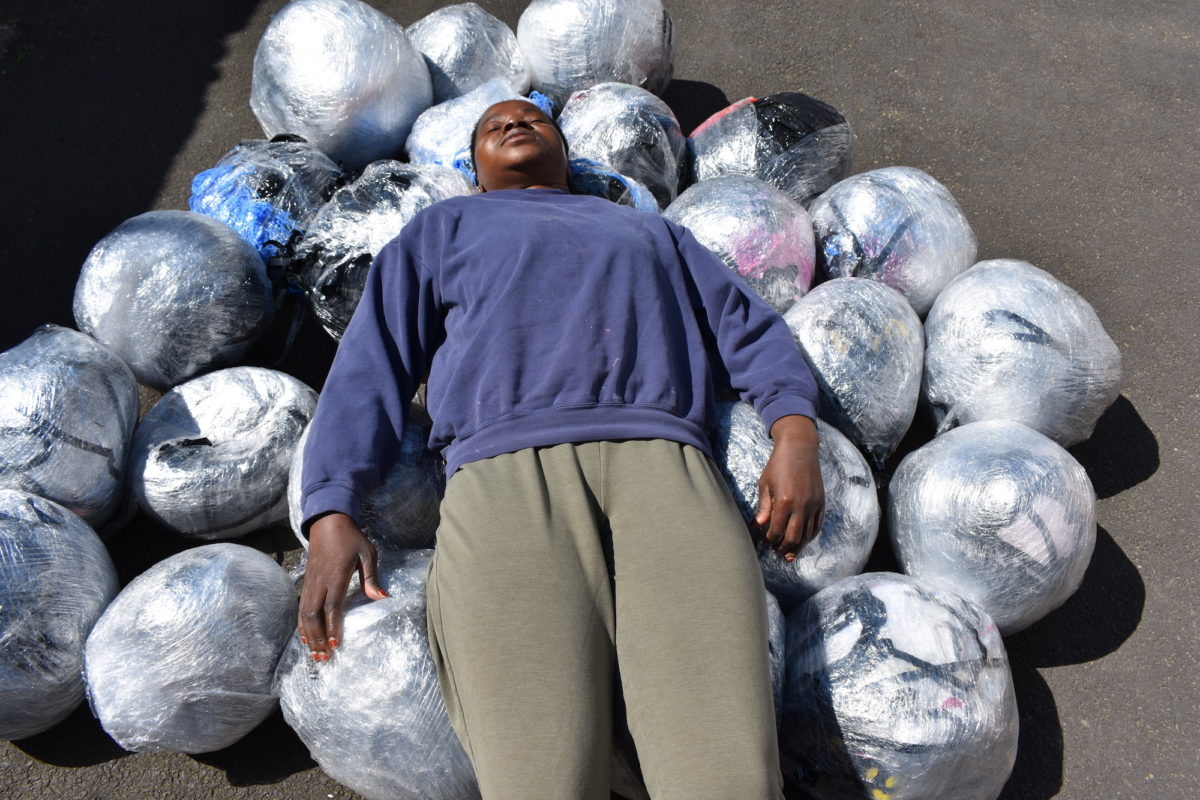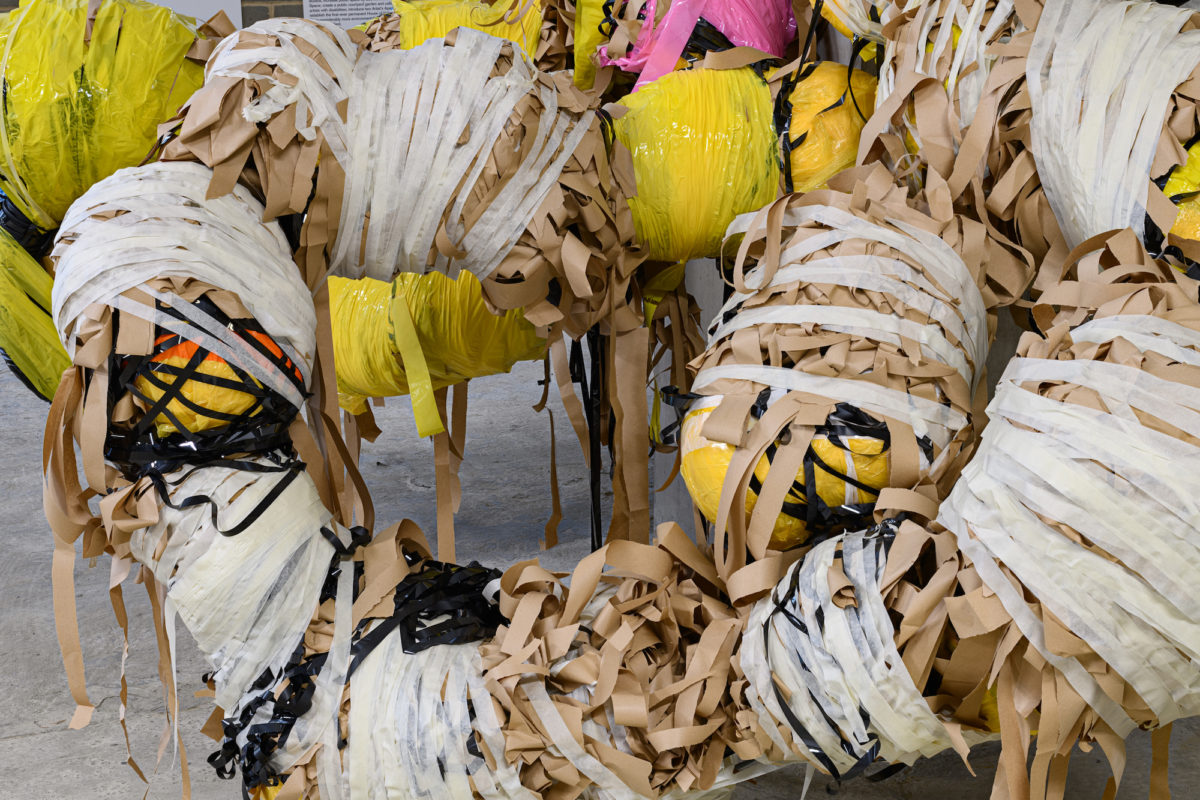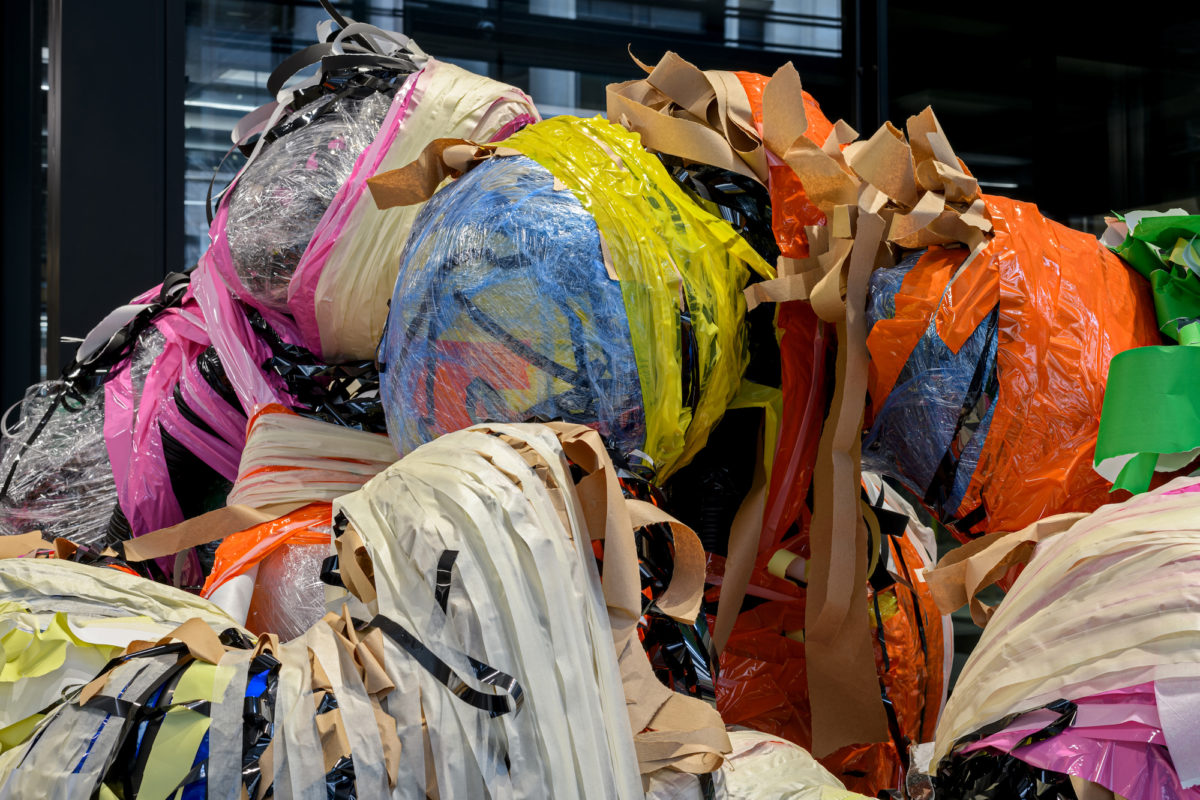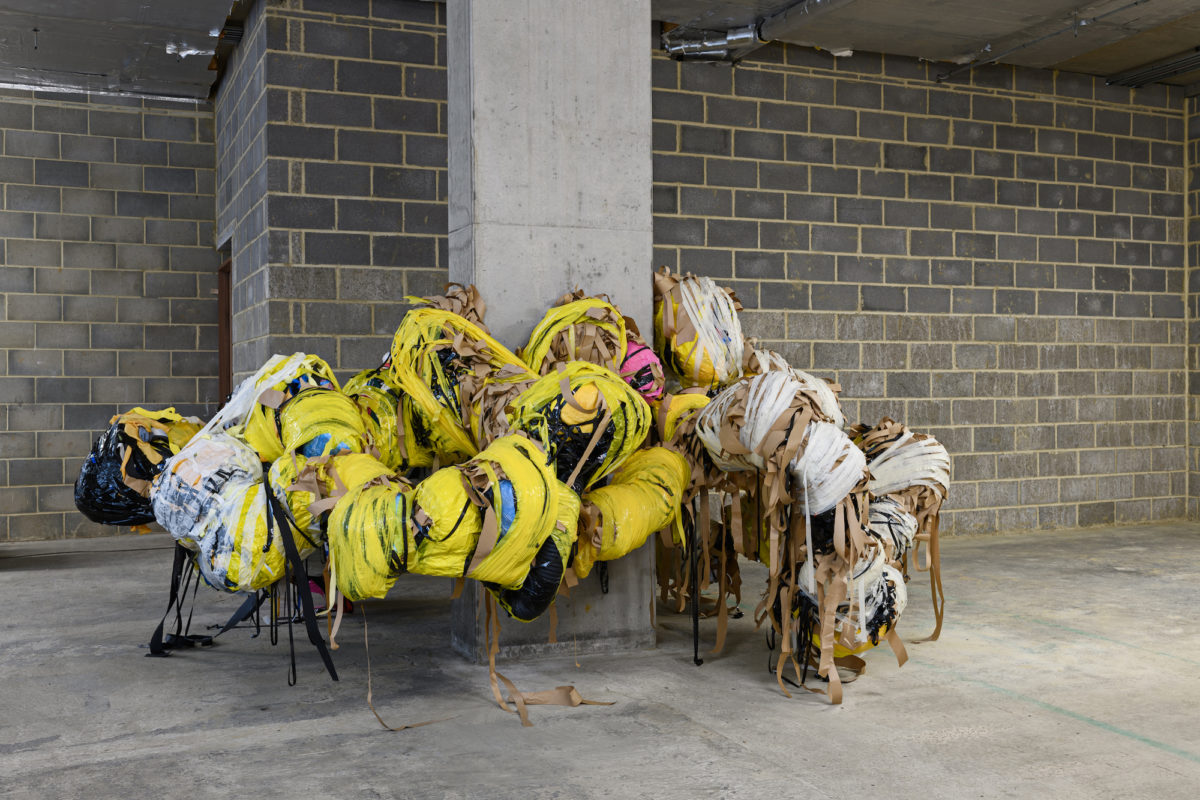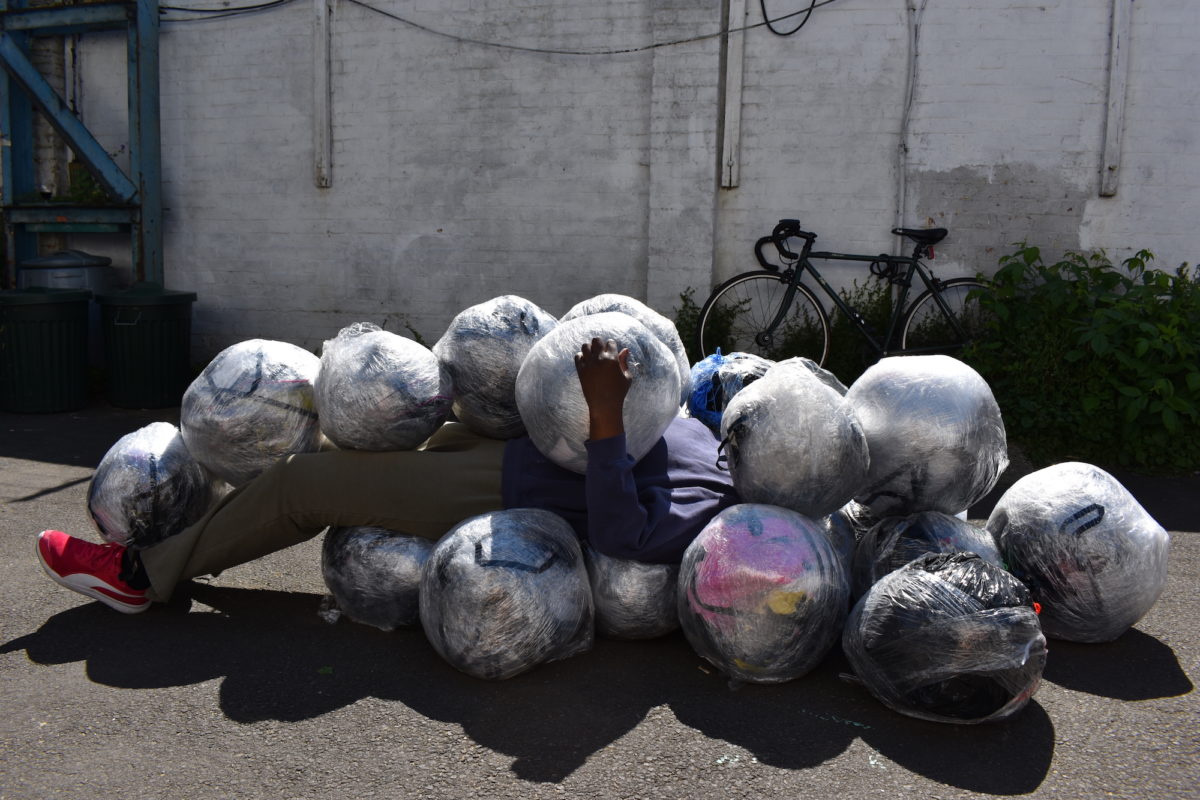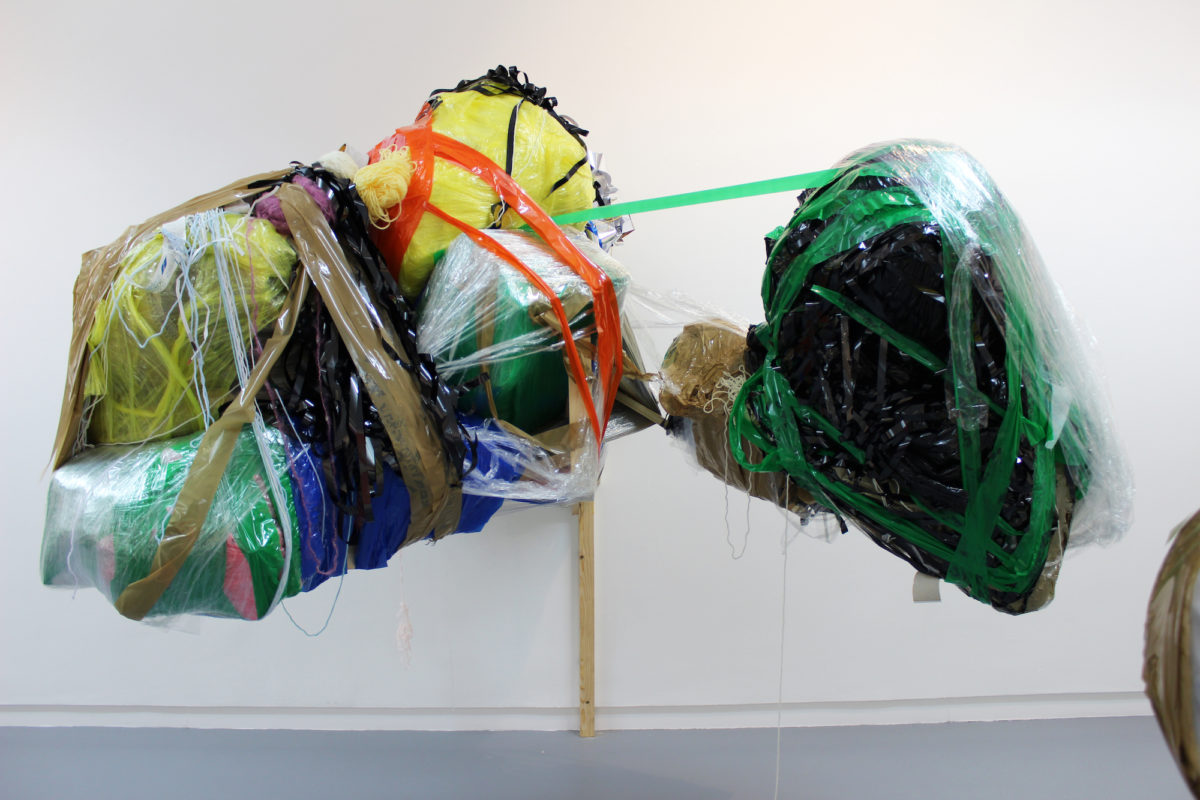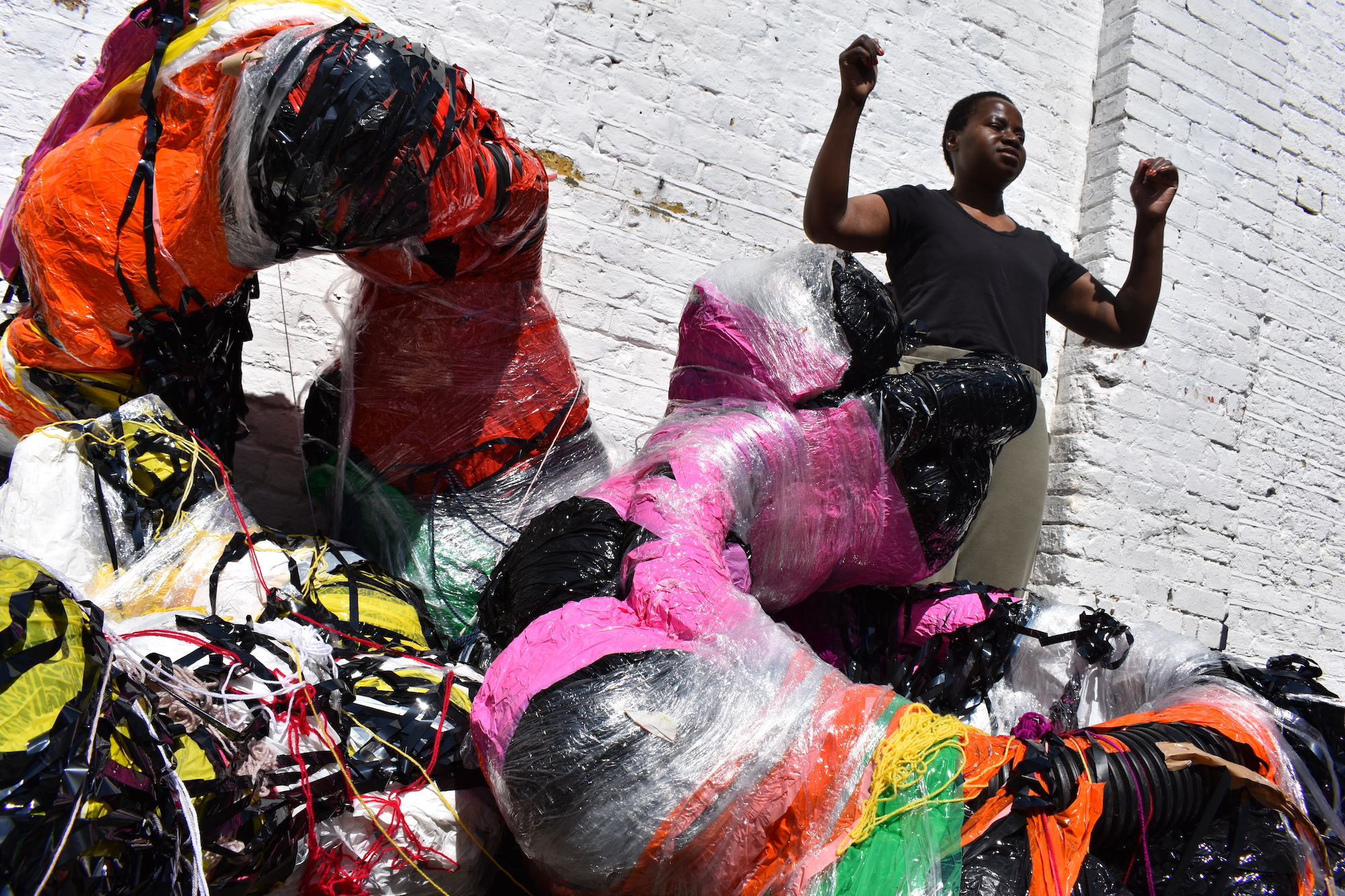
Nnena Kalu is already hard at work when I arrive at her first major London solo exhibition, located just a stone’s throw from the Royal Academy of Arts. The venue is a temporary off-site space for Studio Voltaire, who will be popping up with exhibitions across London throughout 2020. This is the first show of the programme, titled simply: Nnena Kalu.
Certainly, Kalu’s larger-than-life sculptures need little introduction. Enormous mounds of paper, wool and tape bind her various structures together, which are wild and expressive in their gestural forms. It’s as if the pace and arc of Kalu’s arms and hands can be traced in the wending of the cyclical rounds. To look at them is to begin to feel almost dizzy.
The screech of sellotape cuts through the room, a welcome respite from the usual silence that pervades most gallery spaces. It is a stark difference from the usual order of things: the artist herself is present, wrapping, winding and enveloping her sculptures until they swell and burst forth with layer upon layer of material. Kalu will continue to build up the works on display, for two days a week, throughout the duration of the exhibition.
For Kalu, who is autistic and non-verbal, her art practice is an important part of her personal expression. She is assisted in her work by Charlotte Hollinshead, who has run the South London studio of Action Space for more than two decades. She reflects upon Kalu’s work and their longstanding relationship when we meet at the gallery. Hollinshead communicates on behalf of Kalu, and is careful to place her at the centre of our discussion, emphasizing the ways in which she has forged her own creative path.

How long has Nnena been making work as an artist, and what has been her journey to where she is today?
Nnena started working with us in 1997 on a combined music, art and theatre project. I’ve worked with her since then, and we know each other really well. It was apparent from the beginning that she had a deep need to create, to layer and to repeat. When people first come to work with us, we start with some basics, just to see how they use their materials. Nnena spent a good few years trying out lots of big drawing—everything always goes big with Nnena. Big drawing, big painting, big collaging: lots of that. And everything she did was phenomenal immediately.
“It’s Nnena who is driving all this forward. She’s a creative force to be reckoned with“
In her drawings, Nnena would really love repeating clusters of colours and lines that went across the page. She had also been making hundreds of little paper pieces in the studio, where she was ripping paper and then folding it up into little bundles and taping them. It was difficult to work out how to present them, but then we staged this big studio event in a big empty shop. We took all those little cocoon-y pieces, and Nnena started attaching them to a wall and to boxes around the room, then binding them with tape and with wool. It was quite a groundbreaking moment, because it was the first time Nnena had had the space to play with an idea. It was very organic and really exciting.
- Left: Nnena Kalu, Boulder Sculptures, 2018. Right: Nnena Kalu, Studio-Voltaire elsewhere, 2020. Commissioned by Studio Voltaire in partnership with ActionSpace. Courtesy of the artist and Studio Voltaire. Photo by Francis Ware
What is the current working process behind her densely layered sculptures?
Nnena’s cocoons have grown and grown, getting bigger and bigger to more boulder-like forms. She has this desire to bring the materials together, layer them up, bind them up and pack them, and then keep reworking them. Over the years Nnena’s been able to really hone down the materials that she loves. My job is to make sure she’s got those materials, and to find and source new things that might tempt her.
A couple of years ago, we discovered the potential of the VHS tape; Nnena really loves a long line that can keep going, and VHS tape really provided the perfect thing for that. She likes working with wool as well, and long fabric strips. She picks and chooses what she wants, working with a kind of pantry of materials, but she develops a very set process in each installation. The process shifts with each exhibition, and her choice and decision about which materials go well together changes.
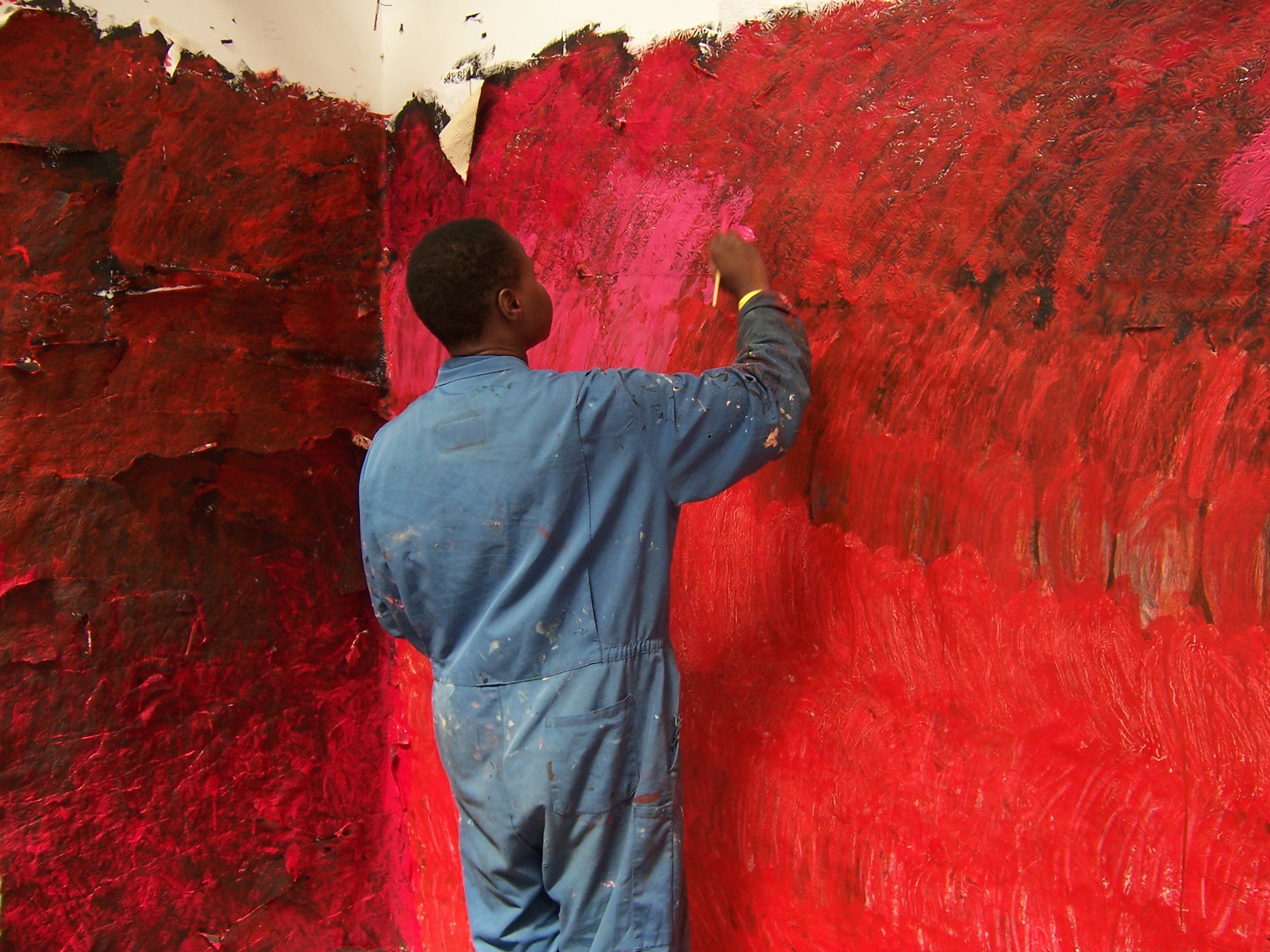
What do you think appeals to Nnena about the various tapes and other household materials that she makes use of?
There are a lovely varied textile qualities, and I think they can bulk up very quickly. Nnena’s got a significant physical impairment in her left eye, so a lot of this work is driven by the movement and driven by the sound and the rhythm, rather than a visual element. It’s not necessarily an aesthetic coming-together of pieces. Nnena’s making the choices about colours and things that she wants to use, but a lot of this is about the physical engagement with it.
In terms of the household materials, it’s about affordability often and what we can get our hands on, because whatever Nnena uses, she uses a lot of! I spend a lot of my life trying to source things which aren’t too costly that we can get in bulk. There’s a lot of re-purposing that goes on. Our job is to constantly think: Nnena’s needing to do this, how can we enable it? It’s a constant delicate process to make sure Nnena’s in charge of what’s happening, not overcrowding her or clustering around what she’s doing.
What is your relationship with Nnena, and how have you managed your collaborative process?
We’re very close, Nnena’s like my second family. But for someone with more complex needs, who requires a lot of support to present and make their work, it’s important to understand that she really does have ownership over this whole thing, and this process. My job is just a constant twenty-year exploration of trying to work out what Nnena likes doing—what works, what doesn’t work—and to help her with her need to make, which is so strong, and to enable it to flow in the right way that suits her. It’s not my agenda but her agenda. She’s totally in control of this, and I think all artists could do with somebody who can tap into their ultimate needs. I’m a sort of glorified assistant, really.
“Nnena works harder than most artists I know, and she has a twenty-year practice. For anyone to dismiss what she does is really frustrating”
We have to be really careful with the wording, and I think we’re still trying to work out how to describe aspects of that relationship without undermining the work she does. Because if we just say something is collaborative, it takes away from the power of Nnena. It’s Nnena who is driving all this forward. She’s a creative force to be reckoned with, and I would just never want her work to be seen as lesser because of my role. I think that’s really important. It always worries me how this will be perceived, so it’s a big risk. This is Nnena’s practice, it’s not mine.
- Left: Nnena Kalu, Boulder Sculptures, 2018, Mixed Media. Right: Nnena Kalu, Project Ability, 2018, Glasgow International, Glasgow. Both courtesy of the artist and Action Space
What are some of the challenges that Nnena has faced in the art world and beyond as an artist with autism, and how has the landscape changed during the time that you have been working with artists with disabilities?
I started doing this in 1996, and I think artists and projects like this would just be dismissed as community arts, or outsider art or disability art. If we ever got in touch with a gallery, they’d always just put you through to their education department and we’d be invited to go for a visit. We were just never taken seriously. The transformation of attitudes within the art world, over the time Nnena has been developing her practice, has been quite significant.
Sometimes the frustration of Nnena not being viewed as an artist has just made me want to smash my head against a wall. Nnena works harder than most artists I know, and she has a twenty-year practice. She’s just really got it, she’s got it all going on. For anyone to dismiss what she does is really frustrating, but that sidelining still happens and it’s just quite tedious. This is a really important exhibition because it’s in a contemporary gallery space in Mayfair, without them pushing some disability agenda.
We’ve had years of trying to just navigate our way through other people’s political agendas to try to keep it pure to Nnena. This show is amazing because she can just be her.
